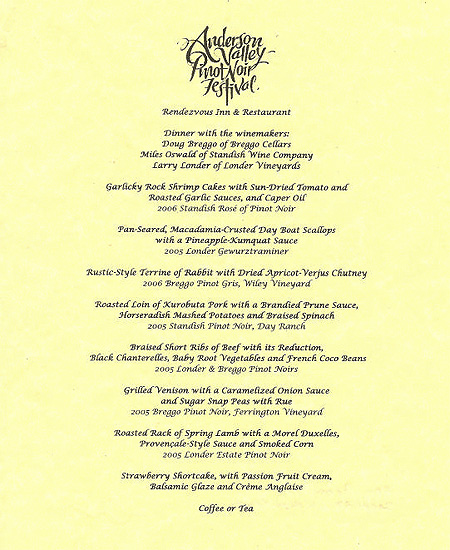Anderson Valley Pinot Noir Festival
I attended the recent 10th Annual Anderson Valley Pinot Noir Festival held
on a sunny weekend May 18-20. The event originated 15 years ago with
winery open houses, but was formalized into a festival in 1997. The festival
has increased in popularity in step with the rise in quality of Anderson
Valley Pinot Noir over the last five years and this year’s celebration was
sold out with 650 people attending. Held the third weekend in May each
year, the festival is sponsored by the Anderson Valley Winegrowers Association.
Excerpts From The Technical Conference
The focus of this conference was the growing and making of Pinot Noir in the vineyards and wineries of
the Pacific Coast and was hosted by Fred Buonanno of Philo Ridge. Glenn McGourty, winegrowing
and plant science advisor for Lake and Mendocino Counties, presented some interesting statistics.
From 1997 to 2005 the planted acreage of Pinot Noir in California increased from 10,000 acres to over
25,000 acres, with a little over 2,000 acres in Mendocino County. Sonoma County led the way with
10,027 acres, Monterey County was next with 4,102 acres, then Santa Barbara County with 3,169 acres,
Napa Valley with 2,263 acres and finally Mendocino County. The average price paid per ton for Pinot
Noir in Mendocino County varies from $500 to more than $3,000 with an average of $2,082 per ton.
Santa Barbara County, fueled by the ‘Sideways’ phenomenon, leads the way at $2,670 per ton topping
Sonoma County which demands $2,509 per ton.
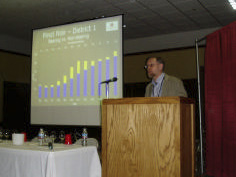
Bill Turrentine, a grape and wine broker, reported on the current state of the Pinot Noir trade. The
overall statewide crush of Pinot Noir was 60,000 tons in 2002 compared with 100,000 tons in 2006.
Despite this increase, the release of the movie ’Sideways’ led to a tight market for bulk Pinot Noir and
currently demand is overtaking supply. Higher production of Pinot Noir is in the future, however, due
to extensive new plantings particularly in relatively warm climate areas such as Lodi (Bronco Wines)
and the importation of inexpensive bulk Pinot Noir from Italy and southern France. Turrentine expects
the market to be flooded with under $20 Pinot Noir, while the $20 to $75 category will remain fiercely
competitive. Inexpensive labels are operating on very thin margins at present, but are content to build their brand, figuring that as supply increases there will be
a softening of grape prices and their wine will become more
profitable in the future. Turrentine (pictured at podium), emphasized
the need for more marketing dollars directed at promoting
Pinot Noir as “fun and tasty, but not snobby,” particularly to the
millennials (those born between 1978 and 2000, roughly 76
million in the U.S.) who are open to new things and seem
attracted to Pinot Noir (below, at Londer Winery).
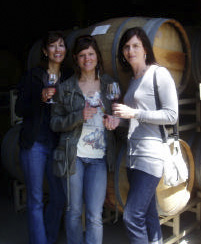
Ed Weber, viticulture farm advisor for Napa County shook up the many growers and winemakers in
attendance with a talk on the dreaded vine mealybug and its relationship to virus leaf roll. Vine mealybug
is a pest that has been identified in 17 counties including the Coachella and Central Valleys,
Central and North Coasts and the Sierra Foothills. There is extensive infestation in Carneros where the
wind spreads the bug widely. At this time, the vine mealybug has not been identified in the Anderson
Valley, but a related species, the grape mealy bug has appeared.
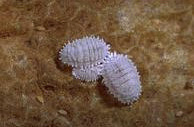
Although not a threat to the vine and grapes, it carries
and spreads virus leaf roll. Leaf roll produces the red
colored leaves seen in vineyards in the fall. The result is delayed
grape maturity and decreased pigment in the grapes.
The vine mealybug is about one-eight of an inch in size and
is covered with white mealy wax. In cooler weather, it hides
behind the bark of the trunk of the vine and even underground
on the roots. As the weather warms, the mealybug
can be found on cordons and the canopy and eventually all
parts of the vine. The vine mealybug secretes honeydew that
is a substrate for black sooty mold and in addition, the pest can infest the grape bunches making the
grapes inedible. The bugs can also transmit vine viruses. Biological control has had some success
including ant control (ants destroy the natural parasites of the mealybug). One of the common methods
of spread is by picking bins which are freely exchanged between wineries.
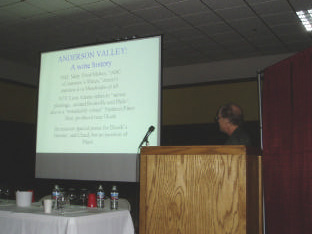
Steve Heimoff, West Coast Editor of Wine Enthusiast Magazine, spoke about his routine of tasting wines
with emphasis on Pinot Noir during his 15 year tenor at the publication. He pointed out that six cool
climate counties in California account for more than 90% of all Pinot Noir. He summarized
the alluring flavors of Pinot Noir as fruity notes (cherries, berries, plum), earthy notes (pomegranate, rhubarb,
licorice, mushroom, cocoa, beet), barrel notes (toast, vanillin, spice), and a touch of funk. Heimoff tastes over 4,000 wines a year under controlled circumstances at his offices where he has a consistent routine and surroundings. He prefers not to taste wines at wineries because the presence of the winemaker and the winery milieu influence his opinion (the so-called "cellar palate"). A considerable number of wines are sampled and never reviewed in the Wine Enthusiast because of poor quality. His personal palate prefers the more Old World or traditional style of Pinot Noir, believing that the high alcohol in many newer Pinot Noirs creates a hot, dense and sweet wine that distorts typicity. Despite the high alcohol, however, "some Pinots get away with it." What he looks for primarily are typicity (the typical taste and texture of Pinot Noir) and balance. One conclusion he has reached after tasting thousands of Pinot Noirs is that clones, rootstock and soil type don’t seem to matter all that much as greatness in Pinot Noir can result from any number of combinations of clones, rootstock and soil type.
Dr. Doug Adams, Professor of Viticulture at University of California Davis discussed tannins and tannin
assay in Pinot Noir. In researching 48 vineyard sites in California, he found a wide range in the amount
of tannin in skins and seeds. He concluded that site has more influence on tannin levels than clones or
rootstocks. He also found that knowing the amount of tannin at harvest cannot be used to predict the
quantity of tannin in the finished wine. Steve Pitcher, a noted wine writer, asked if the tannin level of
the finished wine could be added to wine labels as a guide to one’s tasting experience. Dr. Adams felt
this was ill-advised as many other factors such as acid levels in the wine in combination determine the
perception of tannin (astringency) in the finished wine.
The session wrapped up with a tasting and presentation by winemakers Zach Rasmussen of Goldeneye
and Jerome Chery of Saintsbury. They attempted to answer the question, “Which factor has the
greater influence on wine character - the vineyard or the winemaker?” They swapped grapes from
each other’s vineyards, picked on the same day in 2006. Saintsbury randomly selected three tons of
grapes from the Brown Ranch Vineyard and Goldeneye did the same from their Confluence Block 9
and in turn sent three tons back to Saintsbury. Each winemaker also made wine from their own vineyard.
They used different sized fermenting bins, different lengths of cold soak, different yeasts, and
different cooperage. Barrel samples of each of the four wines were offered for tasting. The discussion
that followed was quite spirited and many dissenting opinions were offered by the audience. No significant
conclusion resulted but the winemakers promise to carry on the experiment for future interest.
Grand Tasting
On Saturday, May 19, the Grand Tasting was held in the middle of the estate vineyard at Goldeneye.
There was a carnival atmosphere under the big tent as 34 participating wineries poured both their latest
releases of Pinot Noir and library wines of past vintages. The sun was out, the air was brisk and
clear, and the smell of barbecue wafted freely throughout the grounds. A silent auction was held to
benefit four local charities and many wine luminaries were in attendance. A large colorful poster, designed
by artist Gerald Reis of Design Studio in Cloverdale, was made to commemorate the event and
was prominently displayed. (see page 8 of this issue's print version).
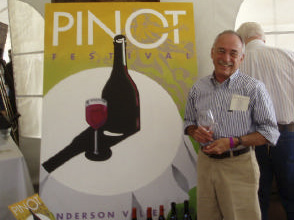
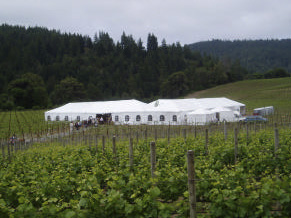
One of the highlights of the Grand Tasting for me was the opportunity to meet and chat with Burt
Williams, formerly winemaker and co-owner of Williams Selyem. Burt now resides in the Anderson
Valley on his 40-acre property and farms his own 12.5 acre Morning Dew Ranch Pinot Noir Vineyard.
He seems quite pleased with the opportunity to grow his own grapes (he never owned a vineyard
while at Williams Selyem) which he sells to his daughter Margi of Brogan Cellars (pictured with Burt’s
wife), Woodenhead Vintners, and Whitcraft. When asked if he planned to make his own Pinot Noir
again, he was noncommittal. He did say, however, with a twinkle in his eye, if he does decide to make
a Morning Dew Ranch Pinot Noir “he will make very small quantities and it will be very expensive!”
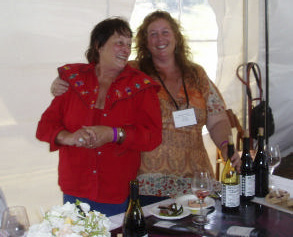
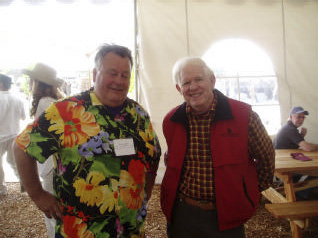
There were a number of outstanding Pinot Noirs I tasted but an event like this is more a celebration
and social occasion than a serious tasting venue. I was able to meet old friends and make many new
contacts and indoctrinate my wife, Patti, in the routine of walk-around tastings. Suffice it say, that the
quality from some producers was astonishingly good, and even less striking examples were of perfectly
fine breeding. In next week’s issue, I will present the results of my extensive tasting of Pinot
Noirs from most of the participants and more.
Winemaker Dinners
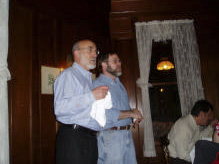
A number of special dinners were hosted by wineries at notable restaurants on the Mendocino Coast.
I attended a very special one at Rendezvous Inn and Restaurant in Fort Bragg featuring the Pinot Noirs
of Breggo Cellars, Londer Vineyards and Standish Wine Company. The restaurant is located in the
living room of a historic residence built in 1897 by Herbert Baum, the town’s apothecary. Located 10
minutes north of the town of Mendocino, the restaurant has been rated #1 by Zagat Guide for food in
Mendocino since 2004. Chef Kim Badenhop (pictured right with Larry Londer on the left next page) departed the business world to train as a chef in Europe. Upon
returning to the United States, he became the chef at the venerable
Café Beaujolais in Mendocino. In 1995, he bought the Rendezvous.
He is a master of matching food and wine and each of the presented
courses made the wines shine. This was one of the best
and most ambitious wine dinners I have EVER had! I highly recommend
a special trip to visit. Rendezvous has 6 rooms as well,
priced nicely at $89 per night including a gourmet breakfast. The
address is 947 N Main St. Fort Bragg, the phone is 1-800-491-8142,
and the website is www.rendezvousinn.com.
